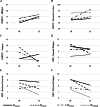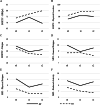Effects of exercise mode and intensity on patient-reported outcomes in cancer survivors: a four-arm intervention trial
- PMID: 37129687
- PMCID: PMC10154283
- DOI: 10.1007/s00520-023-07757-9
Effects of exercise mode and intensity on patient-reported outcomes in cancer survivors: a four-arm intervention trial
Abstract
Purpose: The aim of this study was to compare the effects of different exercise modes (aerobic, resistance) and intensity prescriptions (standard, polarized, undulating) on patient-reported outcomes (PROs) in cancer survivors.
Methods: 107 breast or prostate cancer survivors (52% females, age 58 ± 10 years, 6-52 weeks after primary therapy) performed one out of four training programs, two sessions/week, over 12 weeks: work rate-matched vigorous intensity aerobic training (ATStandard, n = 28) and polarized intensity aerobic training (ATPolarized, n = 26) as well as volume-matched moderate intensity resistance training (RTStandard, n = 26) and daily undulating intensity resistance training (RTUndulating, n = 27). Health-related quality of life (HRQoL, EORTC-QLQ-C30) and cancer-related fatigue (CRF, MFI-20) were assessed at baseline, at the end of intervention and after a 12-week follow-up without further prescribed exercise.
Results: Over the intervention period, HRQoL-function-scales of the EORTC-QLQ-C30 improved over time (p = .007), but no group*time interaction was observed (p = .185). Similarly, CRF values of the MFI-20 improved over time (p = .006), but no group*time interaction was observed (p = .663). When including the follow-up period and pooling the AT and the RT groups, HRQoL-function-scales developed differently between groups (p = .022) with further improvements in RT and a decline in AT. For CRF no significant interaction was found, but univariate analyses showed a non-significant trend of more sustainable effects in RT.
Conclusions: AT and RT with different work rate-/volume-matched intensity prescriptions elicits positive effects on HRQoL and CRF, without one regimen being significantly superior to another over the intervention period. However, RT might result in more sustainable effects compared to AT over a follow-up period without any further exercise prescription.
Clinical trial registration: The study was registered at clinicaltrials.gov (NCT02883699).
Keywords: Aerobic training; Fatigue; Polarized; Quality of life; Resistance training; Undulating.
© 2023. The Author(s).
Conflict of interest statement
The authors disclose any professional relationships with companies or manufacturers who will benefit from the results of the present study and do not have any other conflicts of interest.
Figures



References
-
- Ligibel JA, Bohlke K, May AM et al (2022) Exercise, diet, and weight management during cancer treatment: ASCO Guideline. J Clin Oncol :JCO2200687. 10.1200/JCO.22.00687 - PubMed
MeSH terms
Associated data
LinkOut - more resources
Full Text Sources
Medical
Miscellaneous

